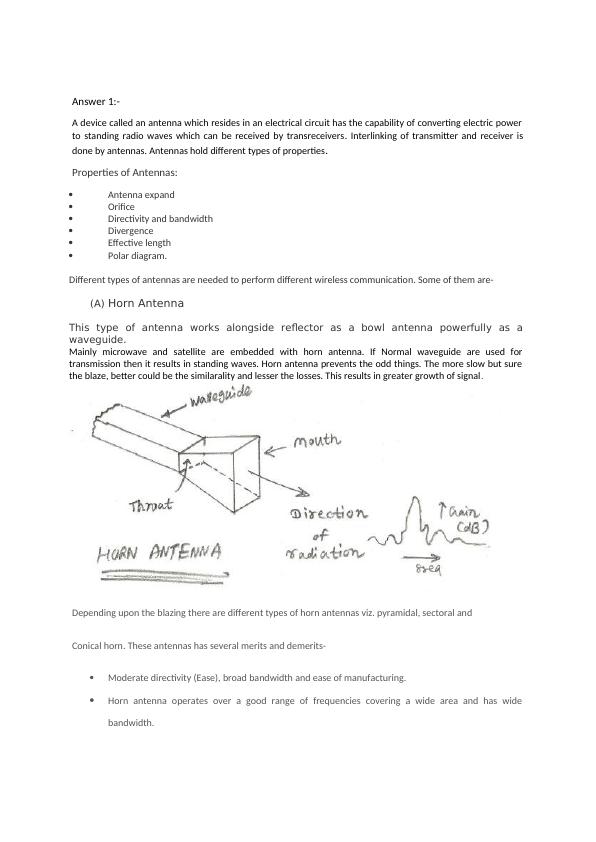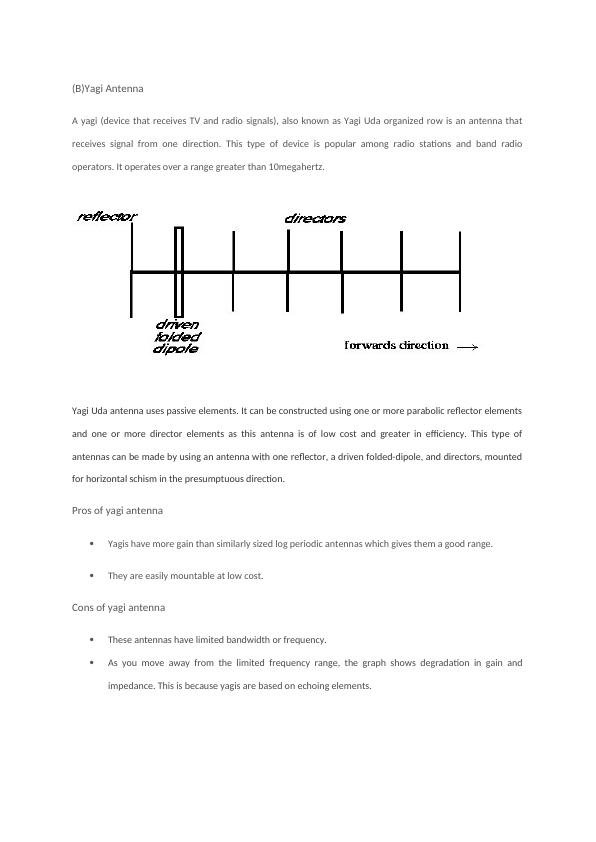41092 - Antenna & Its Classifications - Assignment
Added on 2020-03-02
6 Pages1130 Words37 Views
Answer 1:- A device called an antenna which resides in an electrical circuit has the capability of converting electric powerto standing radio waves which can be received by transreceivers. Interlinking of transmitter and receiver isdone by antennas. Antennas hold different types of properties.Properties of Antennas:Antenna expandOrificeDirectivity and bandwidthDivergenceEffective lengthPolar diagram.Different types of antennas are needed to perform different wireless communication. Some of them are-(A)Horn AntennaThis type of antenna works alongside reflector as a bowl antenna powerfully as awaveguide.Mainly microwave and satellite are embedded with horn antenna. If Normal waveguide are used fortransmission then it results in standing waves. Horn antenna prevents the odd things. The more slow but surethe blaze, better could be the similarality and lesser the losses. This results in greater growth of signal.Depending upon the blazing there are different types of horn antennas viz. pyramidal, sectoral andConical horn. These antennas has several merits and demerits-Moderate directivity (Ease), broad bandwidth and ease of manufacturing.Horn antenna operates over a good range of frequencies covering a wide area and has widebandwidth.

(B)Yagi AntennaA yagi (device that receives TV and radio signals), also known as Yagi Uda organized row is an antenna thatreceives signal from one direction. This type of device is popular among radio stations and band radiooperators. It operates over a range greater than 10megahertz.Yagi Uda antenna uses passive elements. It can be constructed using one or more parabolic reflector elementsand one or more director elements as this antenna is of low cost and greater in efficiency. This type ofantennas can be made by using an antenna with one reflector, a driven folded-dipole, and directors, mountedfor horizontal schism in the presumptuous direction.Pros of yagi antennaYagis have more gain than similarly sized log periodic antennas which gives them a good range.They are easily mountable at low cost.Cons of yagi antennaThese antennas have limited bandwidth or frequency.As you move away from the limited frequency range, the graph shows degradation in gain andimpedance. This is because yagis are based on echoing elements.

(C)Cellular AntennaIt is used in cellular network or mobile network. In this, the network cells is scattered over the area, connectedthree base stations and a fixed transreceiver. These base stations provide network coverage which can be usedfor all types of communication. A cell is combined with other neighbouring cells at different frequenciesproviding a hassle free quality service with each cell.This combination of cells provides cover a wide rangegeographic area. A large number of devices can communicate through these cells moving through one or morebase stations.MeritsThese types of antennas consume less power and are robust in nature.Limited interference for small cells and large number of interfering signals for huge cells.DemeritsIn case of small cells complex infrastructure is required to connect to base station. Infrastructureconsists of switches for call forwarding, location etc.Frequency spectrum should be distributed properly to avoid interference.Electronics is focused on communications. Telegraph started in 1845, calling in 1876, but communicationsreally became popular with the introduction of wireless and the vacuum tube. Today wireless technology and

End of preview
Want to access all the pages? Upload your documents or become a member.
Related Documents
Types of Antenna and Wireless Network Protocolslg...
|11
|2223
|198
Wireless Technology: Antennas, Network Protocols, and Software-Based Networkslg...
|9
|2126
|468
Wireless Networks: Types of Antenna and Network Protocolslg...
|8
|1203
|219
Wireless Networking Conceptslg...
|8
|1997
|228
ITC513 Wireless Networking Concepts Assignmentlg...
|6
|1392
|81
Wireless Networking and Communicationlg...
|6
|1386
|46
